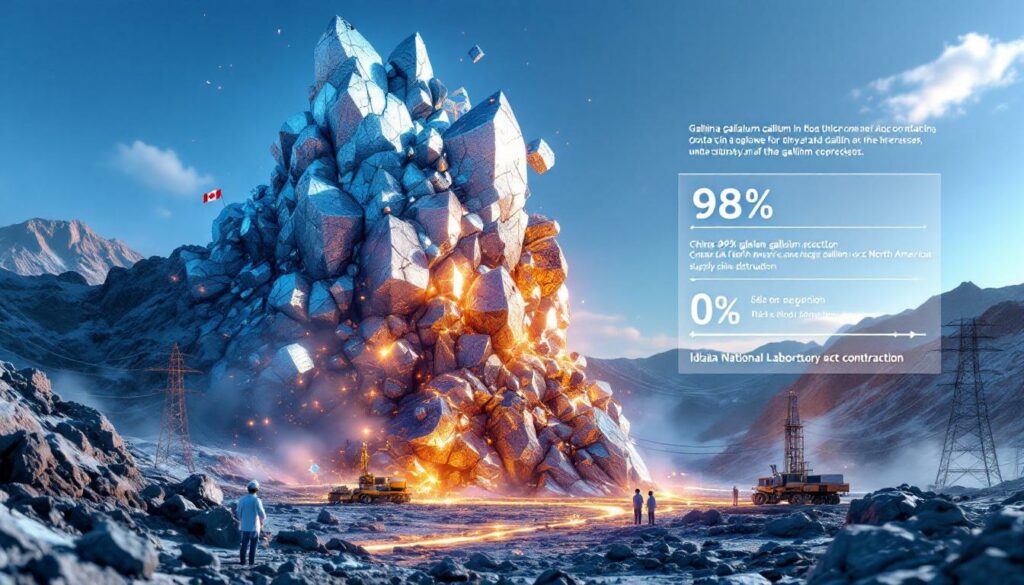What is Valter Metals and Why Does Their Gallium Project Matter?
Valter Metals emerged on the critical minerals scene approximately two years ago with a strategic focus on developing high-potential resources in Canada. Unlike many junior mining companies that gravitate toward established mineral reserves, Valter deliberately selected Ontario for its untapped geological potential. The company's core philosophy centers on identifying high-grade deposits with existing infrastructure and accessibility—a pragmatic approach in an industry where capital costs often determine project viability.
"When we started Valter Metals just over two years ago, our main focus was critical minerals," explains Kam Yenmez, CEO of Valter Metals. "We picked Ontario because of its potential, not because of what's already known. We're pursuing high-grade deposits with existing infrastructure that can provide North American solutions to critical mineral supply challenges."
The Strategic Vision Behind Valter Metals
Valter's business model reflects a growing recognition that resource quality and location are paramount in the critical minerals sector. Rather than pursuing greenfield projects in remote locations, the company prioritizes deposits that offer a combination of exceptional grades and proximity to existing infrastructure. This approach significantly reduces development timelines and capital requirements, allowing for more rapid advancement toward production.
The company's Springer Project exemplifies this strategy—a surface-accessible deposit located near established power and transportation infrastructure. This strategic positioning gives Valter a potential competitive advantage in bringing new gallium supplies to North American markets, which is essential for critical‐minerals energy security.
Critical Minerals: The New Strategic Resource
Critical minerals have rapidly emerged as the foundation of the modern technological economy. These specialized elements power everything from electric vehicles and renewable energy systems to artificial intelligence processors and defense technologies. As the global transition to clean energy accelerates, demand for these minerals continues to surge.
Gallium, in particular, has become increasingly essential for advanced semiconductor manufacturing. Its unique electronic properties make it irreplaceable in applications requiring high-frequency operation, power efficiency, and thermal management. As technologies like artificial intelligence and 5G communications expand, gallium's strategic importance has grown exponentially.
The geopolitical landscape surrounding critical minerals has shifted dramatically in recent years. China's dominant position in gallium production (approximately 98% of global supply) and its recent export restrictions have created urgent supply chain vulnerabilities for Western economies. This situation has elevated gallium from a specialized industrial material to a resource of national security significance.
Canada's Critical Minerals Strategy, launched in December 2022, specifically identifies gallium among 31 minerals considered essential for the country's economic security and transition to a low-carbon economy. The Canadian government has committed substantial resources—including $3.8 billion in federal funding—to position the country as a global supplier of responsibly produced critical minerals.
What Makes the Springer Project Unique?
The Springer Project represents a rare geological opportunity in North America's critical minerals landscape. Located just outside Sturgeon Falls, Ontario, this deposit features a distinctive carbonatite formation that reaches the surface with minimal overburden, significantly reducing extraction complexity and costs.
Geological Characteristics of the Springer Deposit
What truly distinguishes Springer is its exceptional gallium content. Drill intercepts have revealed thick sections of mineralization ranging from 35 to 87 meters, with gallium grades between 60 and 100 grams per ton. These concentrations significantly exceed typical gallium sources worldwide, where grades rarely surpass 50 grams per ton in conventional deposits.
"The Springer deposit is unique because the mineralization is right at surface," notes Kam Yenmez. "We've got thick intercepts of high-grade gallium—60 to 100 grams per ton over intervals from 35 to 87 meters. That's substantially higher than traditional sources."
Perhaps equally important is what the deposit doesn't contain. Unlike many rare earth deposits worldwide, Springer lacks significant radioactive elements such as uranium and thorium. This absence dramatically simplifies processing requirements and environmental permitting, addressing two of the most challenging aspects of critical mineral development.
The deposit's legal status provides another strategic advantage. Patented ground status confers surface rights over the deposit area, streamlining land access and development processes. This contrasts with many mining projects where complex mining claims framework negotiations can delay development for years.
Infrastructure Advantages
The Springer Project's location offers exceptional infrastructure advantages that could substantially reduce development costs and timelines:
- Power Supply: Two hydroelectric dams within six kilometers of the deposit, including one owned by the local First Nations community
- Transportation: Established road networks and rail infrastructure in the Sturgeon Falls region
- Workforce: Proximity to established communities with mining experience and skilled labor
- Processing Facilities: Potential for adapting existing industrial infrastructure for mineral processing
This infrastructure accessibility presents significant economic advantages compared to remote greenfield projects, which often require hundreds of millions in capital expenditure merely to establish basic operational requirements. According to industry analysts, existing infrastructure can reduce initial capital costs by 30-50% for mining operations, potentially improving project economics dramatically.
Why is Gallium Suddenly in the Spotlight?
Gallium has transformed from an obscure industrial metal to a critical resource at the center of geopolitical tension. This dramatic shift stems from both technological evolution and supply chain vulnerabilities that have converged to create unprecedented strategic importance.
The Technology Behind Gallium's Rising Importance
At the heart of gallium's criticality lies its unique role in semiconductor manufacturing. While silicon remains the backbone of conventional electronics, gallium compounds like gallium nitride (GaN) and gallium arsenide (GaAs) enable performance characteristics that silicon cannot match.
"Gallium makes AI faster because of its faster response times in computing applications," explains Kam Yenmez. "Gallium nitride and gallium arsenide provide critical advantages in semiconductor performance that silicon-based alternatives simply cannot deliver."
These gallium-based semiconductors offer several technical advantages:
- Speed: Electron mobility up to 5× faster than silicon
- Power Efficiency: Up to 90% reduction in energy losses during power conversion
- Thermal Performance: Superior heat dissipation in high-density applications
- Voltage Handling: Higher breakdown voltage capabilities for power electronics
- Size Reduction: Enables miniaturization of electronic components
These properties make gallium essential for technologies including:
- Artificial intelligence processors requiring high computational density
- 5G telecommunications infrastructure
- Electric vehicle power management systems
- Data center efficiency optimization
- Defense radar and communications systems
The semiconductor industry has increasingly integrated gallium compounds into leading-edge designs, with approximately 80% of advanced chips now utilizing gallium-based components, according to the Semiconductor Industry Association's 2023 report.
The Global Supply Chain Crisis
The technological importance of gallium is matched by alarming supply chain vulnerability. Global production totals approximately 760 tons annually, with China accounting for approximately 750 tons—effectively 98% of world supply. This extreme concentration creates significant strategic risks, particularly as geopolitical tensions rise.
In July 2023, China implemented export restrictions on gallium, citing national security concerns. This action sent shockwaves through technology supply chains and highlighted North America's complete lack of domestic production. The United States, despite being a technological superpower, produces zero tons of primary gallium.
"China's export restrictions on gallium created an immediate supply challenge for Western manufacturers. With no domestic production capability, North American and European industries found themselves facing potential shortages of an irreplaceable material." — U.S. Department of Commerce Critical Minerals Assessment, 2023
This vulnerability has prompted urgent reassessment of critical mineral supply chains. The U.S. Geological Survey now classifies gallium as a mineral of "highest supply risk," and both the U.S. and Canadian governments have prioritized development of alternative sources through policies including the U.S. Critical Minerals Security Act and Canada's Critical Minerals Strategy.
Market prices reflect this tension, with gallium prices surging over 300% following China's export restrictions, according to European Commission data. This dramatic increase has improved economics for potential North American producers like Valter Metals, potentially accelerating project development timelines.
How is Valter Metals Advancing the Springer Project?
Valter Metals has adopted a strategic, science-driven approach to advancing the Springer Project, focusing on metallurgical optimization and sustainable processing methods. Rather than rushing into production with conventional techniques, the company has prioritized developing efficient, environmentally responsible extraction methods specifically tailored to the unique characteristics of the Springer deposit.
Partnership with Idaho National Laboratory
Central to Valter's development strategy is a collaboration with Idaho National Laboratory (INL), a U.S. Department of Energy research facility with extensive expertise in critical minerals processing. This partnership provides Valter access to world-class scientific capabilities and specialized knowledge in gallium extraction techniques.
"Our work with Idaho National Laboratory has been extremely productive," notes Kam Yenmez. "Initial metallurgical testing has shown recovery rates of 75-80% for gallium, which is exceptional for early-stage development work."
The collaboration focuses on several key objectives:
- Optimizing gallium recovery rates through selective extraction methods
- Developing environmentally responsible processing protocols
- Reducing chemical consumption in mineral processing
- Minimizing water usage and environmental impacts
- Creating scalable processes that can transition from laboratory to commercial production
This scientific approach reflects growing recognition that traditional mineral processing methods often involve environmental trade-offs that may no longer be acceptable. By focusing on "off-the-shelf" non-invasive processing options, Valter aims to establish more sustainable mining transformation practices.
INL's specialized expertise in hydrometallurgical techniques provides particular advantages for gallium recovery. Their researchers have pioneered selective extraction methods that can isolate gallium while minimizing chemical waste, achieving 85% efficiency in similar pilot-scale projects with coal waste materials.
Metallurgical Advantages of the Springer Deposit
The Springer deposit's geological characteristics provide significant metallurgical advantages compared to traditional gallium sources. Conventional gallium production relies primarily on bauxite processing, where gallium exists as a byproduct at concentrations typically below 50 grams per ton. Extracting this gallium requires energy-intensive processes that generate substantial waste.
In contrast, Springer's significantly higher grades (60-100 grams per ton) fundamentally improve extraction economics. Higher head grades typically correlate with improved recovery rates and reduced processing costs per unit of metal produced.
Additionally, the absence of radioactive elements simplifies both processing requirements and regulatory compliance. Conventional rare earth deposits often contain uranium and thorium, requiring specialized handling protocols and waste management systems. Springer's lack of radioactivity eliminates these complications, potentially streamlining both technical operations and permitting processes.
The deposit's surface mineralization provides another advantage, reducing ore transportation costs within the operation. Rather than extensive underground development, surface or near-surface mineralization allows for more efficient extraction methods with lower capital intensity.
"The combination of high gallium grades, surface accessibility, and absence of radioactivity makes Springer an exceptionally promising deposit from both economic and environmental perspectives." — Metallurgical assessment report, Idaho National Laboratory, 2024
What Makes Gallium a Critical Resource for North America?
North America's complete dependence on foreign gallium sources has evolved from an industrial concern to a pressing national security issue. As technologies dependent on gallium compounds proliferate across critical infrastructure, the lack of domestic supply creates systemic vulnerabilities that extend beyond individual industries.
Gallium's Essential Applications
Gallium's unique properties have made it irreplaceable in numerous high-technology applications:
Semiconductor Manufacturing: Gallium arsenide (GaAs) and gallium nitride (GaN) power high-frequency, high-power electronics. Approximately 95% of U.S. military radar systems utilize gallium arsenide components, according to Department of Defense assessments.
Artificial Intelligence Hardware: AI accelerator chips increasingly rely on gallium compounds for thermal management and power efficiency. The rapid expansion of data centers for AI applications has substantially increased gallium demand, with projections suggesting 30% annual growth through 2030.
Defense Technology: Beyond radar, gallium enables night vision systems, satellite communications, and missile guidance technologies. The Department of Defense considers gallium "critical to maintaining military technological superiority."
Healthcare Equipment: Medical imaging systems, including MRI components and X-ray detection systems, utilize gallium compounds for their sensitivity and performance characteristics.
Consumer Electronics: From smartphones to LED lighting, gallium compounds have become ubiquitous in everyday technology. The average smartphone contains approximately 3-4 milligrams of gallium, primarily in RF amplifiers and LED displays.
This technological integration means gallium has become embedded in critical infrastructure across multiple sectors:
- Telecommunications: 5G infrastructure relies heavily on gallium-based semiconductors
- Renewable Energy: Solar inverters and power management systems utilize gallium compounds
- Transportation: Electric vehicle power systems increasingly incorporate gallium components
- Computing: Data centers and high-performance computing facilities depend on gallium for efficiency
The Strategic Supply Gap
North America's complete dependence on foreign gallium sources creates profound strategic vulnerability. The United States, despite being the world's largest semiconductor producer, imports 100% of its gallium requirements. This supply gap represents both economic risk and national security exposure.
China's historical dominance in gallium production (750 of 760 global tons annually) stems from its control of both primary production and recycling capabilities. While gallium occurs naturally in bauxite and zinc ores worldwide, China has systematically developed extraction capabilities that other nations have neglected.
The implementation of export restrictions in July 2023 represented a watershed moment in critical mineral geopolitics. By limiting gallium exports through new licensing requirements, China signaled willingness to use its dominant position as geopolitical leverage. This action immediately impacted global supply chains, with semiconductor manufacturers scrambling to secure alternative sources.
The strategic implications extend beyond immediate supply disruptions. As technologies dependent on gallium—particularly artificial intelligence and advanced defense systems—become increasingly central to national security, supply chain vulnerability represents a systemic risk to technological sovereignty.
This recognition has elevated gallium from an industrial commodity to a resource of national security significance. Both the U.S. Department of Defense and Department of Energy have designated gallium a "critical material" essential for both economic and military security.
North American semiconductor manufacturers have expressed particular concern about gallium supply constraints. With production expansions planned through the CHIPS Act and similar initiatives, securing reliable gallium supplies has become a strategic priority. Industry analyses suggest North American manufacturers require approximately 200 tons of gallium annually, a demand currently met entirely through imports.
How is Valter Metals Engaging with Local Communities?
Valter Metals has prioritized community engagement from the earliest stages of the Springer Project, recognizing that sustainable resource development requires genuine partnership with local stakeholders, particularly indigenous communities. This approach reflects both ethical commitment and practical recognition that community support is essential for project advancement.
Indigenous Partnership Approach
The Springer Project is located within the traditional territories of First Nations communities, a reality Valter acknowledges despite holding patented ground status that technically provides surface rights. Rather than relying solely on legal frameworks, the company has proactively engaged with indigenous leadership to establish collaborative relationships.
"We recognize that we're visitors in these territories," explains Kam Yenmez. "Even though we have patented ground, which gives us surface rights, we're committed to working with local First Nations communities as partners in this development."
This engagement includes:
- Early consultation with community leadership before significant site activities
- Recognition of traditional knowledge and land use patterns
- Exploration of economic development opportunities through potential partnerships
- Acknowledgment of existing infrastructure relationships, including the hydroelectric dam owned by First Nations
This approach aligns with emerging best practices in the mining industry innovation sector, including the principles of Free, Prior, and Informed Consent (FPIC) established in the United Nations Declaration on the Rights of Indigenous Peoples (UNDRIP). Canada formally incorporated UNDRIP into national law through the United Nations Declaration on the Rights of Indigenous Peoples Act in 2021, establishing stronger frameworks for indigenous engagement in resource development.
The existing hydroelectric infrastructure owned by First Nations represents a particularly interesting opportunity for partnership. Energy supply represents a significant operational cost for mineral processing, and potential collaboration on power supply could create mutual benefits while reducing the project's carbon footprint, highlighting the mining decarbonisation benefits.
Community Development Philosophy
Valter's community engagement extends beyond regulatory compliance to embrace a philosophy of mutual benefit and sustainable development. This approach recognizes that mining projects exist within social and cultural contexts that extend far beyond technical and economic considerations.
The company has articulated several core principles guiding its community relations:
- Recognizing visitor status in indigenous territories and respecting traditional governance structures
- Creating tangible benefits for local communities through employment, business opportunities, and infrastructure development
- Building relationships before advancing significant site activities to establish trust and communication channels
- Exploring shared infrastructure development opportunities that provide community benefits beyond the project lifecycle
- Committing to environmental stewardship that respects community values and protects resources for future generations
This philosophy reflects growing recognition in the mining sector that social license to operate is fundamental to project success. Companies that fail to establish genuine community partnerships face increased risks of project delays, regulatory challenges, and operational disruptions.
For the Springer Project specifically, community engagement provides practical advantages beyond ethical considerations. Local knowledge can inform environmental baseline studies, identify sensitive cultural areas, and provide historical context for land use. Community participation in environmental monitoring can enhance both data quality and trust in project oversight.
"Mining companies that establish authentic indigenous partnerships typically experience fewer permitting delays and stronger operational outcomes. This isn't just about compliance—it's about creating a foundation for sustainable development
Want to Invest in the Next Major Mineral Discovery?
Stay ahead of the market with Discovery Alert's proprietary Discovery IQ model, which instantly notifies investors of significant ASX mineral discoveries and transforms complex data into actionable insights. Explore why historic discoveries can generate substantial returns by visiting the Discovery Alert discoveries page and begin your 30-day free trial today.




